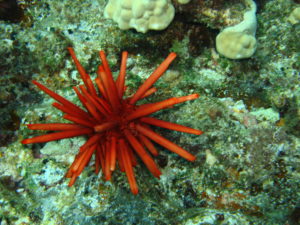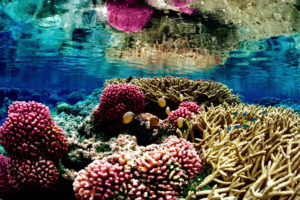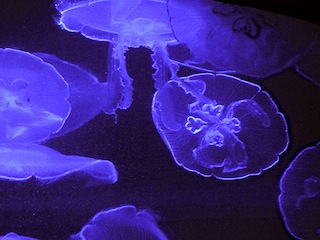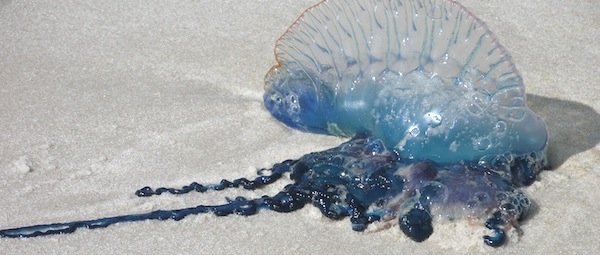This is part of a two-post series about dangerous animals in the ocean water surrounding Hawaii that you need to be aware of. The first article covered, “Bugs in Hawaii.” This one takes a look at some of the dangerous marine animals in Hawaii.
Long-Spined Venomous Sea Urchins (Diadema paucispinum, Echinothrix diadema, and Echinothrix calamaris)

There’s a reason why this is a bright, contrasting color – don’t step on me!
Slate-pencil Sea Urchin by Ryan Oelke is licensed under CC BY-SA 2.0. Image may have been resized or cropped from original
In Hawaiian language, “Wana”. Pronounced “vah-na”. Though eaten by locals and considered a delicacy (tastes like opihi), to step on an urchin is a bad experience. Three species are dangerous in Hawaii, those named above in the subheading. These are wicked circular or oval spined beasts up to 10 inches, that attach to coral, rocks, and other submerged structures directly under some of the prime surfing spots in Hawaii. This long spiny urchin is the scourge of surfers all over Hawaii. If you have lived in Hawaii for any amount of time, you already know someone that is living with wana barbs inside their foot, which, with time, dissolve. The problem is, before they dissolve, you are going to go through tremendous pain from the pointy spines, the venom they carry, and possibly infection as a result of punctured skin. I’ll talk more about possible infection in Hawaii’s waters later. The venom is released through the shorter hollow spines as something contacts the sharp tip. Though you may have trouble seeing them if you are snorkeling or diving because they collect organic debris, and sometimes small pebbles, you know immediately if you’ve stepped on one. It is nothing like a coral cut – which often isn’t even felt.
The spines can break off and lodge in your body, and need to be removed as much as possible. The area around the punctured skin will be stained purple or black, the same color as the offending organism. This fades with time. Hospital or clinic treatment is well-advised because all medical personnel that deal with this problem have been well trained on how best to treat the site. There are even substances that can be applied that help soften the barbs so they are absorbed into the skin faster than through the normal process.
Probability of Encountering Wana in Hawaii – Unfortunately, if you spend a lot of time in the water, you are likely to put your foot down on a piece of coral or rock and step right onto a long-spined venomous sea urchin. Wana are very common. It happens. It happened to me only a couple of times, and I never suffered with them broken off in my foot like a lot of people do. It doesn’t take long to learn not to put your foot on the coral in any circumstances.
Stings – It hurts a lot to step on urchins, and it will hurt for a while. Soaking the wound in warm water, as warm as you can stand, breaks down the toxins. Soaking in vinegar can also help to break down the calcium-carbonate spines so they are absorbed into your body if you can’t, or the medical personnel cannot remove them all with tweezers. Eventually the spines dissolve and you’re good to go. Some people may suffer infection as a complication, so keeping an eye on the wound is essential so you can have it treated by experts, not at home in your restroom.
Outcome Prognosis – Good in most cases. It is painful, and even debilitating for a while, but eventually without secondary infection, it works itself out.
Precautions – Avoid at all costs, stepping on coral with your feet – whether you have reef shoes on, tennis shoes, or fins, whatever. I have had thin water shoes on my feet and stepped on an urchin that went right through those thin rubber shoes. Don’t put yourself in a situation where you are snorkeling or riding a board where you may have to put your feet down onto the reef because it is so shallow.
Coral Cuts and Abrasions

The reef ecosystem is delicate and amazing.
Coral Reef at Palmyra Atoll National Wildlife Refuge by U.S. Fish and Wildlife Service Headquarters is licensed under CC BY 2.0. Image may have been resized or cropped from original
Coral is alive. The danger is in stepping on it or brushing against it because it is so rough, that it can scrape the skin and even cause lacerations, very easily.
Probability of Encountering – Very high if surfing, bodyboarding, or bodysurfing. There is coral all over the Hawaiian Islands where swimmers and other water enthusiasts are having fun.
Lacerations, Scrapes – Treat immediately, don’t continue playing in the water until you’re ready to go get it treated. If you’re bleeding, you’re ready to go home. If you don’t know what you’re doing, go to a clinic and have them clean it out. I know it sounds funny, to have a clinic clean out your scrape or cut, but, you don’t want it to get infected. Infection is very common after a coral cut, I’d say it’s the rule and it happens every time. Did for me!
Outcome Prognosis – Probably fine, infection of some sort is normal, but most people recover fully. However, because there is usually some form of infection present, whether from the coral itself or bacteria in the water, coral cuts can take up to months to heal. Be aware that some people are allergic to the substances in coral that can enter the body through a break in the skin. Signs of infection and anaphylactic shock symptoms should be dealt with immediately.
Precautions – Of course you don’t want to ever step on coral or brush against it for any reason. Some surfing spots have coral reef under the breaking wave, that’s why it’s breaking! Do be careful not to be caught out on a coral reef when the tide has gone out and left you in a place you can’t help but be crawling across the coral. Not a good position to be. Been there myself in Waikiki and at Magic Island, Ala Moana Beach Park.
Conus – Deadly Sea Snails (Conidae)
In Hawaiian language, “Poniuniu”. As weird as it is, walking alongÀšÃ‚ a beach or diving in Hawaii and picking up a Conus shell with a snail still inside, can lead to excruciating pain, and possibly even death. Yes, snails in Hawaii can be potentially deadly, though there have been no fatalities here yet. There are 34-40 species of Conus snail in the waters of Hawaii. The largest, the leopard Conus (Conus leopardus) can reach 9 inches in length. The three that are especially dangerous are theÀšÃ‚ textile, striated and marbled cones.ÀšÃ‚ These dangerous snails are carnivorous and hunt marine life nocturnally. The snails have a harpoon-like ‘tooth’ which contains potent neurotoxic venom which renders prey helpless. The venom is also cytotoxic, destroying cells of the organism. There is no antivenin available.
Probability of Encountering – Very low, unless you are actively looking for shells. Only shells with live snails in them can harm you. I have heard stories of people putting shells in their pocket, and the snail bites them in the thigh, through the cloth of the pocket.
Stings – Small Conus snails can give a painful sting. Larger snails can induce respiratory failure and death. Typically stings include intense pain, some swelling, numbness, tingling, and vomiting. Symptoms can be delayed by days. Sever cases involve muscular paralysis, vision difficulty, and respiratory problems – even death. If you are stung, watch for signs of going into anaphylactic shock and seek treatment immediately. There is no antivenom, and treatment involves providing life support until the venom is metabolised by the victim.
Outcome Prognosis – For small snails, the prognosis is usually good. For large snails, better to get to the hospital quickly. There have been no fatalities in Hawaii to date.
Precautions – Don’t pick up snail shells if you are not an expert on snail species. There are only a few snails that can hurt you, but you’d better know which ones.
More information – Cone Snail Video by National Geographic at YouTube.
Portuguese Man-O-War (Physalia physalis)
Hawaiians call them many names, “Ili Mane`o”, “Pa`imalau”, “Palalia” or “Pololia”. On the windward sides of all islands, there is an abundance of these purple-blue Portuguese Man-O-War, or “Blue Bottles.” They are floating siphonophore (not jellyfish) that have a bubble inside their body that keeps them afloat. Unfortunately it also acts as a sail and catches the wind, so when the wind is blowing onshore, there are many of these floating pests all over the water and washed up on the beach. Their tentacles are usually between 33 and 160 feet in length, and they inject venom into your skin when you brush up against them, causing intense pain.
Probability of Encountering – High if you spend much time in the ocean in Hawaii. If you live in Hawaii you will likely have an encounter at some point.
Stings -ÀšÃ‚ There are varying degrees of stings, and reactions to them. I spent hundreds of hours, probably thousands of hours in the water in Hawaii over six years. I was stung repeatedly by tentacles of these jellyfish-like monsters. I remember getting stung and just staying in the water because it wasn’t that bad. I think I didn’t have any bad reaction to them at all. I remember having red welts across my back, legs, arms, cheek, and other places, and they stung a bit, but nothing like what many people describe as the worst pain of their lives. Do be exceptionally careful though, because you might be a person that reacts very badly to the venom. Most people urinate in a cup and pour it on their stings. It appears to help.
Outcome Prognosis – Red welts and some pain, some itchiness are apparent for up to 2-3 days for most people. If you’re going to have an allergic reaction, it usually happens within the first few hours of exposure to the toxins.
Precautions -ÀšÃ‚ These pests are present in greater numbers when the wind is coming onshore and blowing them into the beach. You can usually find some on the beach first, and that will notify you that they are also in the water. If you see one man-of-war floating on the water, get out immediately, there are likely hundreds more around. I don’t remember being stung through a shirt or shorts, so covering up with a long-sleeve surfing shirt can help mitigate the extent of a sting.
More Information – Portuguese Man-of-War Video by National Geographic, at YouTube.
Winged Box Jellyfish (Carybdea alata) – and other Jellyfish.

Jellyfish- James Brennan Molokai Hawaii by James Brennan is licensed under CC BY 2.0. Image may have been resized or cropped from original
The winged box jellyfish is 1-3″ long with tentacles around 2 feet in length and appear approximately 7-10 days after the full moon. They are present for 2-3 days and then aren’t usually to be found. There is the occasional oddball that can be found anywhere, so caution is always indicated. They show up a week after the full moon on the on the leeward shores of the Hawaiian islands. Leeward means off-shore winds are blowing. So, when the wind is blowing from the shore toward the ocean, and during the timeframe outlined, box jellyfish can sometimes be found.
Probability of Encountering – High if you spend a lot of time in the water, especially during windy periods with onshore wind.
Stings -ÀšÃ‚ Stay calm and remove the tentacles if you can see them, using something other than your finger. Use something like a piece of cardboard, sock, or something else. Do not touch the object again once used to brush away the jellyfish. Flood stings with vinegar for at least 30 seconds, minutes if possible. Transport victim to hospital if any serious breathing or consciousness problem occurs.
Outcome Prognosis -ÀšÃ‚ The pain from the winged box jellyfish is much more intense than that of the Portuguese man-of-war or other jellyfish for most people. The other way you can tell is that the pain from the box jellyfish lasts for around eight hours, and not just 15 minutes to an hour as with the man-of-war. Scarring can last for years for the box jellyfish, and only days for the man-of-war. Keep in mind that nobody has died from a box jellyfish sting in Hawaiian waters. You will likely be fine. Treat stings with vinegar and see a doctor or emergency room for any severe symptom related to anaphylactic shock.
Precautions -ÀšÃ‚ Lifeguards keep a vigilant look for box jellyfish and sometimes close entire beaches if there is a threat. If you are swimming on a beach without lifeguards, you must be aware that jellyfish, man-of-war, sharks, and other dangers might be present (undertows, large surf, etc.). It is better, if you don’t know the ocean well, to attend only beaches with lifeguards present.
Beaches that are prone to having winged box jellyfish: Ala Moana Beach, Waikiki Beach, Hanauma Bay & Makaha Surfing Beach
My Box Jellyfish Story – I had been snorkeling at a deserted beach on Maui for a few hours. As I came in to the shallow water I sat down and pulled off my fins. I felt an excruciating pain on the inside of my left thigh. I instinctively jumped up and ran in to the beach, slapping my thigh to get whatever was burning me, away. When I got to the beach my leg was literally on fire with pain. Up to that point the only pain I had ever felt that was comparable was being stung by the barbs of a stingray after stepping on one in Florida while wade-fishing. The pain in my thigh was almost making me lose my mind it was so strong. I felt my breathing become labored and I wondered if I was going to die right there in front of my girlfriend. I can’t even describe the pain, but it was like someone had poured battery acid from a car on my leg and it was eating through to my bones. It was that intense. Peeing on it didn’t help. Fresh water didn’t help. We went to the doctor who watched me for signs of going into shock. I was treated and released in a few hours. I had a 5 inch diameter road-map of welts on my leg for about six years. It slowly faded away and today I can only see a slight mark where the box jellyfish got me. I have been stung by many things in the past… The box jellyfish and stingray are two that you could not pay me enough to ever endure again. Do be careful in Hawaii’s waters!
Dangerous Bacteria – Staphlococcus, Streptococcus, Etc.
I have had my share of cuts made by coral while surfing and bodyboarding at various spots on the islands. When I first arrived on Oahu I was fearless and stupid, emphasis on the latter, and I’d go wherever the waves were – without much consideration for the sharp coral reefs underneath. I had a coral cut or scrape a couple of times per month. After two years of this foolishness I noticed I was getting a boil every now and then, somewhere on my body. The location was different all the time, but usually on my upper torso, not my legs so much. If you’ve had boils, you know they are no fun. They’re an annoyance, and once they’re gone they are nothing to think about. However, I began having them on average once per month. Every month, without fail. This went on for about two years, even after I moved up to New York City. Multiple rounds of very strong antibiotics eventually put a stop to the recurring infection.
It was then I learned from some of the best dermatologists in the world, that the Pacific Ocean around the islands of Hawaii – especially Waikiki, are filled with opportunistic bacteria like Staphlococcus and Streptococcus! If you get a coral cut, you have a good chance of getting an infection from some wicked bacteria in the water. It is essential to get your wounds cleaned out professionally, and still, you have a chance of coming down with boils or something else.
Probability of Encountering – Very high if you are swimming in the waters of Waikiki and cut or scrape yourself.
Infection – Infection usually occurs with lacerations that occur in the water in Hawaii. That has been my and others’ experience. Do take care to clean any wound very thoroughly, and it definitely wouldn’t hurt to have it done at a hospital or clinic where they know what they’re doing. The risk of infection is great.
Outcome Prognosis – As I mentioned above, I’ve had many coral cuts while surfing and bodyboarding, and all my friends have too. The worst thing I’ve ever seen happen was my own recurring staph infection which took many courses of antibiotics to fix. Usually infections are mild to moderate and hospitalization is not necessary.
Precautions – Be cautious of the coral reef and urchins (wana) while in the water. If you have open sores or other wounds, don’t get in the water as bacteria can infect easily when there is a break in the skin’s surface.
Sharks!
This will be a quick overview of sharks in general. I have another in-depth post about sharks I’ll be publishing within the next week, and I’ll link out from this section to that article.
Sharks attacks happen at the usual rate of 3-4 per year in the Hawaiian Islands. There has not been a fatality as the result of shark attack for over a half-dozen years. When sharks attack they don’t usually eat the entire body of a person, they usually bite and let go. Sometimes they take an arm or part of a leg, or other hunk of flesh, but they don’t hang around and pick a person apart – usually. It’s actually remarkable, considering the extent of some of the injuries suffered by shark-bite victims, that more don’t bleed to death or go into shock and die.
If you are able to hit the shark in the nose, you have a better chance of persuading the shark to leave the area. A number of people have done just that, and lived to tell about it.
There are some very dangerous sharks in Hawaii, the worst is the Tiger Shark (Galeocerdo cuvier). But, unless you are spending day after day surfing or spear-fishing, you are very unlikely to ever be attacked by a shark at all, or even see one. Read more about these incredible creatures below.
Here is our detailed Sharks in Hawaii article
Summary
As you can see there are a few dangerous marine animals and bacteria to keep up to speed about if you are planning on spending time in the oceans around the islands of Hawaii. Most things can be avoided by being smart – including sharks. There are times of day and night they can be found, and preferences they have for feeding which you can be aware of that will help you avoid them. Probably the biggest risk of injury you face in the water, is a sting from the abundant Portuguese Man-of-War that float on the surface and come into shore during onshore wind periods.


